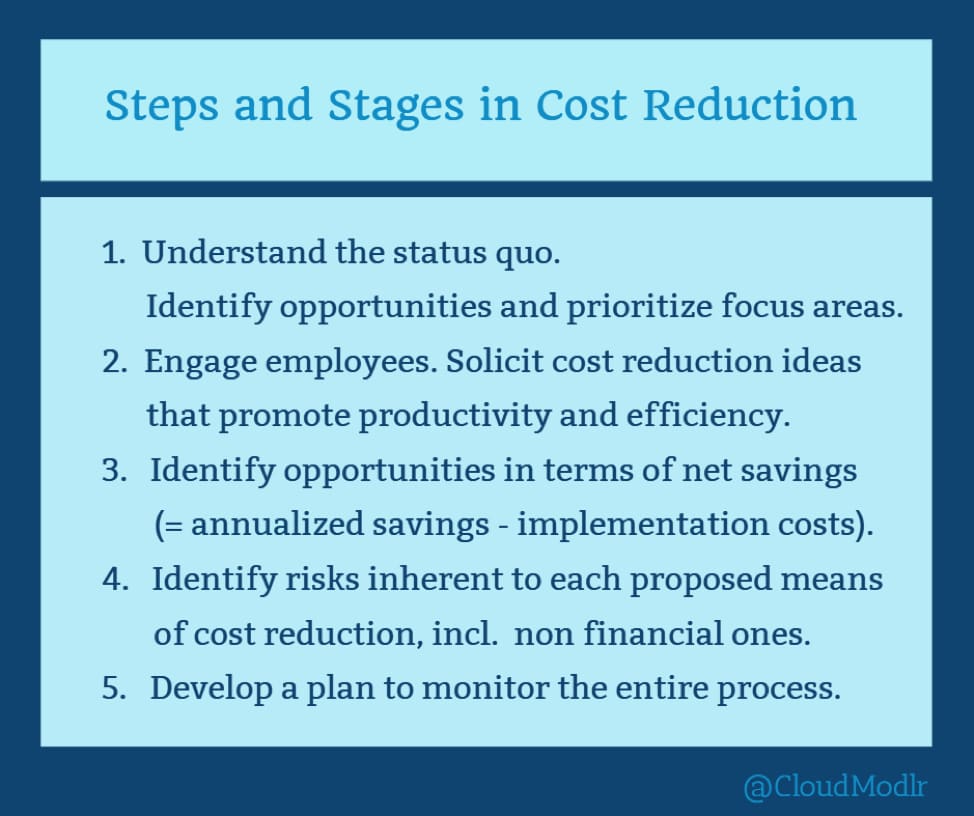
You can call it by any name you wish, if it can be made more palatable: cost optimization, enterprise cost reduction, cost cutting, cost reduction, business process reengineering, process improvement initiatives, streamlining operations, productivity maximization, productivity improvement; the list goes on. What label you use matters little except for gaining employee support and engagement that is critical for success in achieving sustainable changes within your business.
Why Cost Out?
Needing to cut costs is a perennial business reality.
The need to cut costs in any business may be driven by external factors or internal factors. Very often, it may be a mix of both.
The dominant external pressures to reduce costs include economic cycles, major market changes, changes in the political or regulatory environments, pressure from parent companies and recent or imminent changes in ownership.
Strategic initiatives, changes in corporate structure, rationalizing or streamlining operations including procurement and supply organization include the internal drivers of cost reduction. Internal drives for cost reduction or optimization are typically led by CEOs, CFOs and other C-suite executives.
During the global financial crisis, we saw many companies scrambling to reduce costs. A mid-2009 Ernst & Young survey of over 500 decision-makers operating in 11 largest economies of the world and representing 11 different industries showed that 86 percent saw cost consciousness as "extremely important". Another 12% saw it as moderately important. Yes, that adds up to 98 percent of those surveyed agreeing that cost consciousness was a key business concern. 1
When asked why cost reduction was so important, 4 out of ten participants cited the need to secure economic survival. Nearly a fifth of companies said that cost management is a continuous process. Other reasons included cost cutting as a way to create entrepreneurial leeway for action and as a way to make use of market opportunities arising in a crisis.
Seeking to optimize costs - a leadership imperative
Today, we see more and more companies embrace a culture of cost optimisation, by embedding an ownership culture in their workforce, and incentivizing continuous improvement. Increasingly businesses are finding out that they need to re-jig their operations to stay ahead and thrive, as opposed to merely survive.
It is now a leadership imperative to identify and liberate resources periodically so that companies can fuel growth and momentum.
Here's what this means for today's firms: In good times and bad, you can expect there to be an ongoing demand and push for business cost reduction.2
Your business or business unit may be next, if you've not done it already.
Great expectations from cost reduction initiatives

Companies expect to improve one or more of the following with cost reduction initiatives:3, 4, 5
- To better respond to negative macroeconomic and market changes
- To improve financial performance including cash flow and profit
- To exploit new business opportunities - often by liberating resources captive in less lucrative business areas and investments
- To implement a cost leadership strategy
- To prepare the company for significant changes
- To improve business efficiency and effectiveness
- To sharpen their competitive edge within the industry
- To prepare and launch a system for continuous improvement
- In the worst-case scenario, to merely survive
Quite often you will find a number of these on your corporate wish list.
Your approach to cost reduction
You could take one of three choices in your approach to cost reduction.6
- Go for quick wins. This may be ideal if the financial position is difficult, but if your goal is survival, you may not have much of a choice in the matter.
- At the other extreme, companies can take a transformational approach to cost reduction. Companies with a healthy financial position, seeking dominance as a corporate strategy may pursue this approach, which may take a longer time frame, exceeding beyond one year.
- In the middle lies the balanced approach, best suited for companies with stable financial position, aiming development as a key corporate strategy. This approach may take anything from 6-12 months.
This is of course, just one way of looking at cost out initiatives.
You may find other approaches, depending on who you talk to or what you read. Later in this article, we have outlined how we, at MODLR, approach such initiatives.
Steps and stages in cost reduction

Whether you plan to go for quick wins or opt for a longer term strategic transformation or something in the middle, each initiative and project must go through certain steps to be effective. These steps and the stages may vary, by the scope of the program - whether organization-wide or department-wide - the approach of the consultants you hire and the timeframes involved.
These are the steps you need to cover:
1. Understand the status quo.
This means using an array of diagnostic tools that help you identify opportunities and then prioritize high-level opportunities and focus areas.
There are a variety of tools, methods and techniques you can use:
- Pareto analysis helps you identify priority areas, going by the Pareto Principle [rephrase - that 80 percent of results come from 20 percent of the effort.]
- Value Chain Analysis can help you recognize the most valuable activities and highlight how they could be changed or improved.
Understanding costs.
Distinguish good costs from bad costs, advises PwC.7
The key priority in strategic cost reduction is targeting resources where they can earn the best return, rather than just cutting costs in itself. The starting point is differentiating the capabilities needed to fuel profitable growth ('good costs' targeted for investment) from low-performing business and inefficient operations ('bad costs' targeted for overhaul or elimination).
Good costs are capabilities that differentiate your business, move it closer to customers, and enable it to develop new value propositions. Determining and focusing on what really matters to customers in today's market.
Bad costs are non-essential areas of spending.
Understanding and grading costs by necessity-essential, non-essential, nice to have etc. and recording reasons as to why each item is ranked as given.
In doing so, it is also important to remember that not everything with cost implications can be boiled down to money. For example, when you go through a list of employee welfare items, the value of free coffee can be known. But the idea of cutting off perks such as these - or anything that was free till now - can affect morale, motivation and productivity.
Identifying repetitive tasks ripe for automation may be useful at this state as well. In a later stage you may be able to decide whether automation in fact helps reduce costs.
Identifying and analysing bottlenecks using processes like critical path analysis is also a part of understanding the status quo.
- Analysing handoffs is another useful area to explore when looking at company processes. What happens during handoffs between different processes, divisions, and units may be worthwhile because often different groups do not get together to focus on handoff issues that may result in unnecessary costs.
2. Soliciting cost reduction ideas that promote productivity and efficiency
We are giving this as a separate point because it helps with employee buy-in to change initiatives.
Engagement of employees in the change process is change management best practice.
It is important to recognize that people who do the work know how best it can be improved, and what needs to be done to become more efficient or productive. They can tell you of the bottlenecks that you may even not be aware of because they somehow manage to solve these problems among themselves.
Also, if people who must implement changes see their own ideas also in the mix, as opposed to all ideas being forced upon them by outsiders or from the top, you will find the change process flows smoothly.
Soliciting ideas in an open democratic way, allowing implementers rate what to keep, what to drop and what to reduce will really get some buy ins. This makes execution and implementation easier and more effective.
3. Identifying opportunities
You can take various approaches here including across the board savings, benchmarking and value analysis. Your goal is to analyse of all the information and identify which specific cost reduction opportunities you wish to pursue.
Going beyond totals, it is necessary to:
- Identity annualized savings for each opportunity area
- Identify implementation costs for each idea; because each change is likely to involve its own set of costs.
- Calculate the net savings you can expect after considering the above points.
4. Identify risks inherent to each proposed means of cost reduction
Implications of cost reduction go beyond their dollar values or purported savings.
If you are not careful, the proposed changes may risk affecting the quality of products or service, customer relationships, company reputation and even brand image.
"Customers have long memories that extend across economic cycles" notes the authors of a 2009 Ernst & Young whitepaper.8 "They will not forget (or forgive) opportunistic actions or other violations of trust, but they will remember excellent customer service. The risk of damaging your reputation with your core customers as you execute your cost reduction program is higher now than it was a few years ago because of greater customer connectedness."
Cost reduction initiatives can also negatively impact your employees, opening up a whole new Pandora's Box you'd rather not open. Short-sighted decisions in cost reduction may rock the boat and affect motivation, engagement, turnover and absenteeism, escalating your costs elsewhere, which may not be offset by the savings you gain on any individual cost reduction efforts. This is why identifying and quantifying risks is a critical component of any change initiative.
For example, you may find that eliminating the supply of free coffee can save you're a lot of money. But what is the risk of giving up free coffee in break rooms? Answer: It negatively affects employee morale - taking away any existing perks always do - and may even possibly affect their productivity.
This discussion can easily veer away into an argument on motivation; of hygiene factors and motivators. This would add an additional layer of perspective to your decision making.
Giving employees a choice on the matter may help. Inviting their inputs may help. But each and every step you take may have its inherent costs and that means you need to balance the risks vs the benefits and cost implications.
Whether you look at it from a market and customer's perspective or that of your employees, it is a good idea to go into cost-saving initiatives with a systemic thinking approach. Taking time to understand the non-monetary implications may help you make more rational and palatable decisions. Then you are less likely to encounter wide resistance in implementation by your employees. And whatever your decisions will not negatively affect your business reputation, market position and competitiveness.
5. Developing a plan to monitor the entire process
It is important to create and publish a high-level plan that will let you closely monitor the cost out process from the beginning to the end. It must be constantly updated and accessible to all involved. This keeps all those who are affected by the changes and have a role in implementing or enabling the changes in the loop, smoothing out the process. It will also help you save time in meetings.
Whether you are managing your cost reduction efforts on your own or obtaining the services of external consultants, you need to complete each of the above stages and then go on to implementation and monitoring of progress against the plan. At each stage, keep in mind that the critical measure of success of a cost reduction programme is in the savings you get from it.
How a cost out programme is structured
To give you an idea of how external consultants may structure a cost reduction project, here's how we, at MODLR, approach such initiatives.
In the initial weeks (weeks 1-3) we focus on diagnostics in order to define the scope of the assignment and to identify high-level opportunities and estimate the potential for quick wins and longer-term strategic initiatives.
During Phase 1 (weeks 4-6), our focus is on delivering quick wins through the following steps:
- Defining status quo on identified focus areas
- Refining opportunities and estimated benefits
- Prioritizing for potential based on estimated benefits as well as complexity
- Developing a business case for each high potential opportunity
- Creating a roadmap for implementing changes
During Phase 2 (weeks 6 -24), our focus will be on:
- Developing a detailed implementation plan for each value initiative
- Implementing operating and governance models to execute the plans
- Identifying and deploying resources
- Executing value initiatives one by one according to implementation plans
- Tracking and monitoring progress of initiatives against defined targets
- Escalating action where necessary and managing roadblocks
In Phase 3 (6 months on) we look at producing sustained savings for our clients by:
- Training and developing client staff and empowering them to lead ongoing efforts
- Enforcing new policies and procedures
- Tracking savings and progress
- Conducting "check back" sessions to troubleshoot and clarify matters needing further attention.
If you are conducting your cost outs on your own, you'd still need to go through similar stages and cover all bases to make sure your project delivers expected results.
Mistakes to avoid in your cost reduction initiatives
Whatever the approach you take, and whether or not using the services of outside experts, here are some common mistakes you need to avoid in cost reduction projects:
Do not forget that change takes time.
Sustainable change requires patience and careful execution. Most strategic cost saving efforts take time to bear fruit. While quick win efforts help cut costs in obvious and easy places - the low hanging fruit - most strategic initiatives take six to nine months or more of sustained effort to truly realise savings.
Do not mix up your priorities.
Do not let tactical cost reductions get in the way of strategic reductions that are more effective and sustainable long term.
Do not lose focus.
It is easy to let cost reduction implementation work get lost among other initiatives. Business expansion, business model changes or other strategic matters can take up most of your time, halting progress on the cost reduction efforts.
Do not focus on scale forgetting profitability.
In most businesses it is not the size and scale of the effort that matters; it is the bottom line. Nonprofits may have different views on this matter, naturally.
If you have experience with cost reduction programmes, you will have more points to add here. We urge you to share them with us in the comments.
The Modlr Team
1 Raffaele Muscetta. Launching a Successful Cost Take Out Programto Achieve Operational Excellence. https://www.slideshare.net/muscetta/cost-out-programs PwC. More for less: Five steps to strategic cost reduction. 2016. Accessed online on 29 September 2017
2 https://www.pwc.com/gx/en/insurance/publications/firing-on-all-cylinders-five-steps-to-strategic-cost-reduction.pdf
3 Deloitte & Touche Regional Consulting Services Limited. Cost cutting: Methodology and tools. 2016. Accessed online on 29 September 2017 at https://www2.deloitte.com/content/dam/Deloitte/ru/Documents/Operation/ru_cost_cutting_eng.pdf
4 Raffaele Muscetta. Launching a Successful Cost Take Out Program to Achieve Operational Excellence. https://www.slideshare.net/muscetta/cost-out-programs
5 PwC. More for less: Five steps to strategic cost reduction. 2016. Accessed online on 29 September 2017 at https://www.pwc.com/gx/en/insurance/publications/firing-on-all-cylinders-five-steps-to-strategic-cost-reduction.pdf
6 Deloitte & Touche Regional Consulting Services Limited. Cost cutting: Methodology and tools. 2016. Accessed online on 29 September 2017 at https://www2.deloitte.com/content/dam/Deloitte/ru/Documents/Operation/ru_cost_cutting_eng.pdf
7 PwC. More for less: Five steps to strategic cost reduction. 2016. Accessed online on 29 September 2017 at https://www.pwc.com/gx/en/insurance/publications/firing-on-all-cylinders-five-steps-to-strategic-cost-reduction.pdf
8 Ernst & Young. Cutting costs not customers: Maintaining customer loyalty in a challenging market. 2009. Accessed online on 10 October 2017 at http://www.ey.com/Publication/vwLUAssets/Cutting_costs_not_customers_-_Maintaining_customer_loyalty_in_a_challenging_market/$FILE/Cutting_costs_not_customers.pdf






